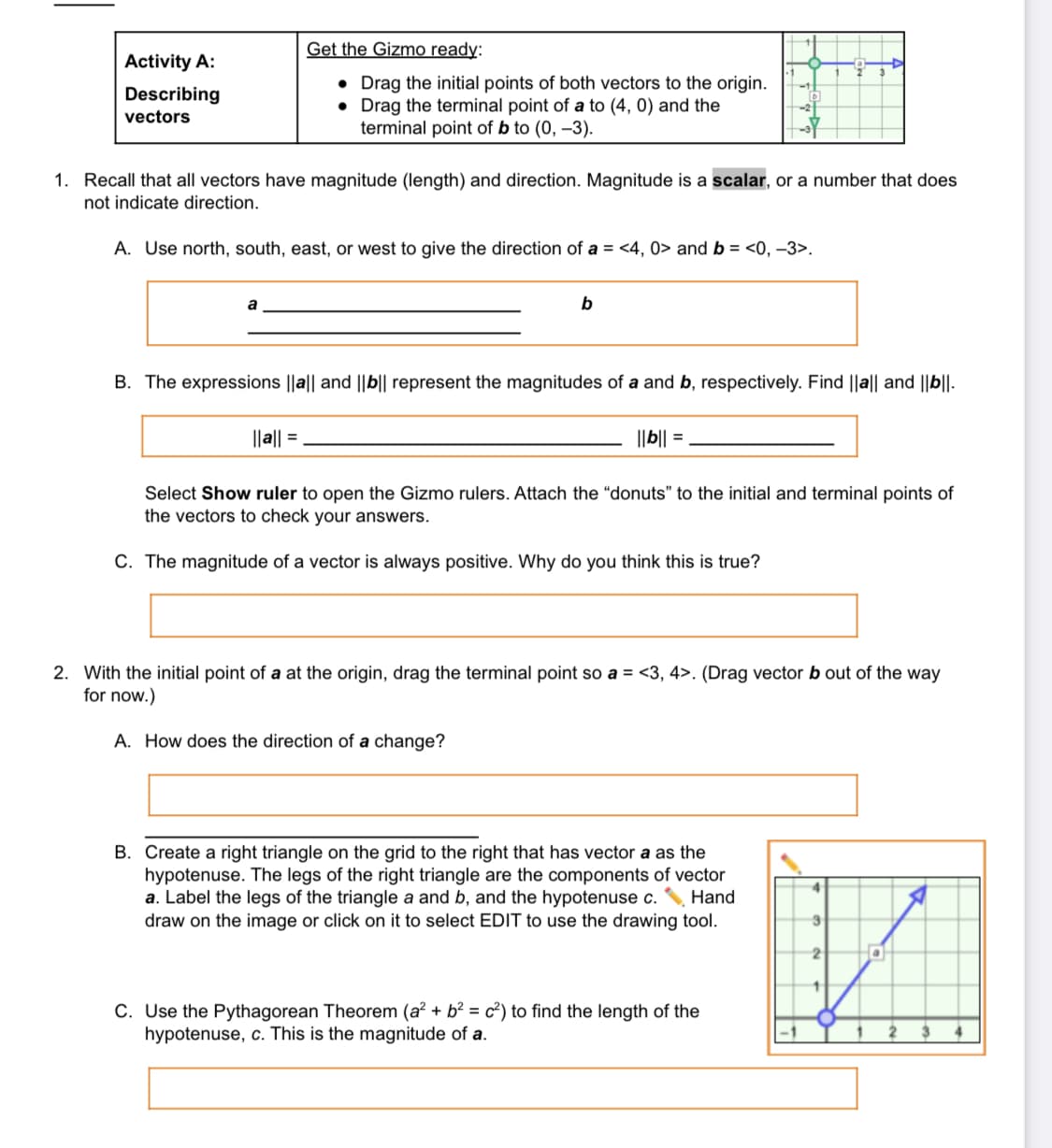1. Recall that all vectors have magnitude (length) and direction. Magnitude is a scalar, or a number that does not indicate direction. A. Use north, south, east, or west to give the direction of a = <4, 0> and b = <0, –3>. a b B. The expressions ||a|| and ||b|| represent the magnitudes of a and b, respectively. Find ||a|| and ||b||. ||a|| = ||b|| = Select Show ruler to open the Gizmo rulers. Attach the "donuts" to the initial and terminal points of the vectors to check your answers. C. The magnitude of a vector is always positive. Why do you think this is true?
1. Recall that all vectors have magnitude (length) and direction. Magnitude is a scalar, or a number that does not indicate direction. A. Use north, south, east, or west to give the direction of a = <4, 0> and b = <0, –3>. a b B. The expressions ||a|| and ||b|| represent the magnitudes of a and b, respectively. Find ||a|| and ||b||. ||a|| = ||b|| = Select Show ruler to open the Gizmo rulers. Attach the "donuts" to the initial and terminal points of the vectors to check your answers. C. The magnitude of a vector is always positive. Why do you think this is true?
University Physics Volume 1
18th Edition
ISBN:9781938168277
Author:William Moebs, Samuel J. Ling, Jeff Sanny
Publisher:William Moebs, Samuel J. Ling, Jeff Sanny
Chapter2: Vectors
Section: Chapter Questions
Problem 33P: A trapper walks a 5.0-km straigt4ine distance from his cabin to the lake, as shown in the following...
Related questions
Question
Please, can someone explain how to do this? I don't understand.

Transcribed Image Text:Get the Gizmo ready:
Activity A:
• Drag the initial points of both vectors to the origin.
• Drag the terminal point of a to (4, 0) and the
terminal point of b to (0, –3).
Describing
vectors
1. Recall that all vectors have magnitude (length) and direction. Magnitude is a scalar, or a number that does
not indicate direction.
A. Use north, south, east, or west to give the direction of a = <4, 0> and b = <0, –3>.
b
B. The expressions ||a|| and ||b|| represent the magnitudes of a and b, respectively. Find ||a|| and ||b||.
||a|| =
||b|| =
Select Show ruler to open the Gizmo rulers. Attach the "donuts" to the initial and terminal points of
the vectors to check your answers.
C. The magnitude of a vector is always positive. Why do you think this is true?
2. With the initial point of a at the origin, drag the terminal point so a = <3, 4>. (Drag vector b out of the way
for now.)
A. How does the direction of a change?
B. Create a right triangle on the grid to the right that has vector a as the
hypotenuse. The legs of the right triangle are the components of vector
a. Label the legs of the triangle a and b, and the hypotenuse c. Hand
draw on the image or click on it to select EDIT to use the drawing tool.
3.
C. Use the Pythagorean Theorem (a? + b? = c²) to find the length of the
hypotenuse, c. This is the magnitude of a.
Expert Solution
This question has been solved!
Explore an expertly crafted, step-by-step solution for a thorough understanding of key concepts.
This is a popular solution!
Trending now
This is a popular solution!
Step by step
Solved in 2 steps with 2 images

Knowledge Booster
Learn more about
Need a deep-dive on the concept behind this application? Look no further. Learn more about this topic, physics and related others by exploring similar questions and additional content below.Recommended textbooks for you

University Physics Volume 1
Physics
ISBN:
9781938168277
Author:
William Moebs, Samuel J. Ling, Jeff Sanny
Publisher:
OpenStax - Rice University

University Physics Volume 1
Physics
ISBN:
9781938168277
Author:
William Moebs, Samuel J. Ling, Jeff Sanny
Publisher:
OpenStax - Rice University